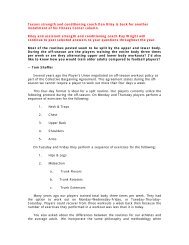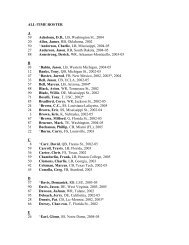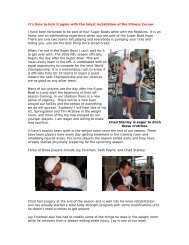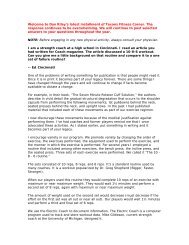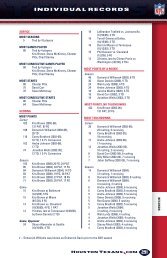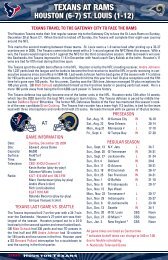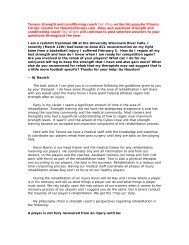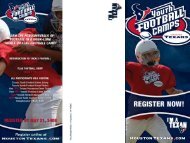Texans strength and conditioning coach Dan Riley is back for ...
Texans strength and conditioning coach Dan Riley is back for ...
Texans strength and conditioning coach Dan Riley is back for ...
You also want an ePaper? Increase the reach of your titles
YUMPU automatically turns print PDFs into web optimized ePapers that Google loves.
You can observe from the upper body workout l<strong>is</strong>ted above, our players only per<strong>for</strong>m<br />
four exerc<strong>is</strong>es (36 total reps) <strong>for</strong> the chest, four exerc<strong>is</strong>es (42 total reps) <strong>for</strong> the<br />
upper <strong>back</strong>, <strong>and</strong> four exerc<strong>is</strong>es (42 total reps) <strong>for</strong> the shoulders.<br />
We do not waste time <strong>and</strong> energy by per<strong>for</strong>ming non-productive sets. Our players<br />
warm up on the first upper (or lower) body exerc<strong>is</strong>e by per<strong>for</strong>ming several<br />
preparatory sets. Once the warm-up process <strong>is</strong> complete our players exert a<br />
maximum or near-maximum ef<strong>for</strong>t on each set per<strong>for</strong>med.<br />
Some workouts require athletes to per<strong>for</strong>m an endless number of non-productive<br />
sets (sub-maximal ef<strong>for</strong>ts). The body must use some recovery energy on every<br />
repetition per<strong>for</strong>med regardless of how light the weight <strong>is</strong>. Hans Selye tells us that<br />
we do not have an unlimited supply of adaptation energy. The ability to recover from<br />
exerc<strong>is</strong>e <strong>is</strong> limited. There<strong>for</strong>e after warming up our players, every set must have a<br />
purpose. And that purpose <strong>is</strong> an attempt to increase <strong>strength</strong> on every set<br />
per<strong>for</strong>med each workout, until <strong>strength</strong> maintenance becomes the goal.<br />
In my early years with the Redskins our players per<strong>for</strong>med three total body<br />
workouts per week. The volume of exerc<strong>is</strong>e was less than our current twice per week<br />
workouts, but in looking <strong>back</strong> I firmly believe I was over-training our players.<br />
I have learned to l<strong>is</strong>ten to our harder working players <strong>and</strong> have made volume<br />
adjustments in our running program <strong>and</strong> our lifting program based upon their<br />
feed<strong>back</strong>.<br />
Dr. Hans Selye (in h<strong>is</strong> book, “The Stress of Life”) teaches us that one half of the<br />
successful fitness <strong>for</strong>mula <strong>is</strong> stress (exerc<strong>is</strong>e) <strong>and</strong> the other, <strong>and</strong> equally important<br />
half, <strong>is</strong> adaptation (rest).<br />
Too much exerc<strong>is</strong>e <strong>and</strong> not enough rest produce an athlete incapable of<br />
recovering from one workout (or practice) to the next. During my younger days I<br />
was guilty of over-training players. It can only be described as bad <strong>coach</strong>ing.<br />
I am constantly searching <strong>for</strong> in<strong>for</strong>mation that can help us better determine how<br />
little exerc<strong>is</strong>e <strong>is</strong> needed to produce the best results.<br />
Jason, your question about over-training <strong>is</strong> a good one. Some day I hope there<br />
will be a simple, scientific, <strong>and</strong> non-invasive method to monitor over-training. Until<br />
then we must rely upon keeping accurate records to compare progress from one<br />
workout to the next. We must also seek the opinions of our most d<strong>is</strong>ciplined workers<br />
<strong>and</strong> make adjustments when necessary.



